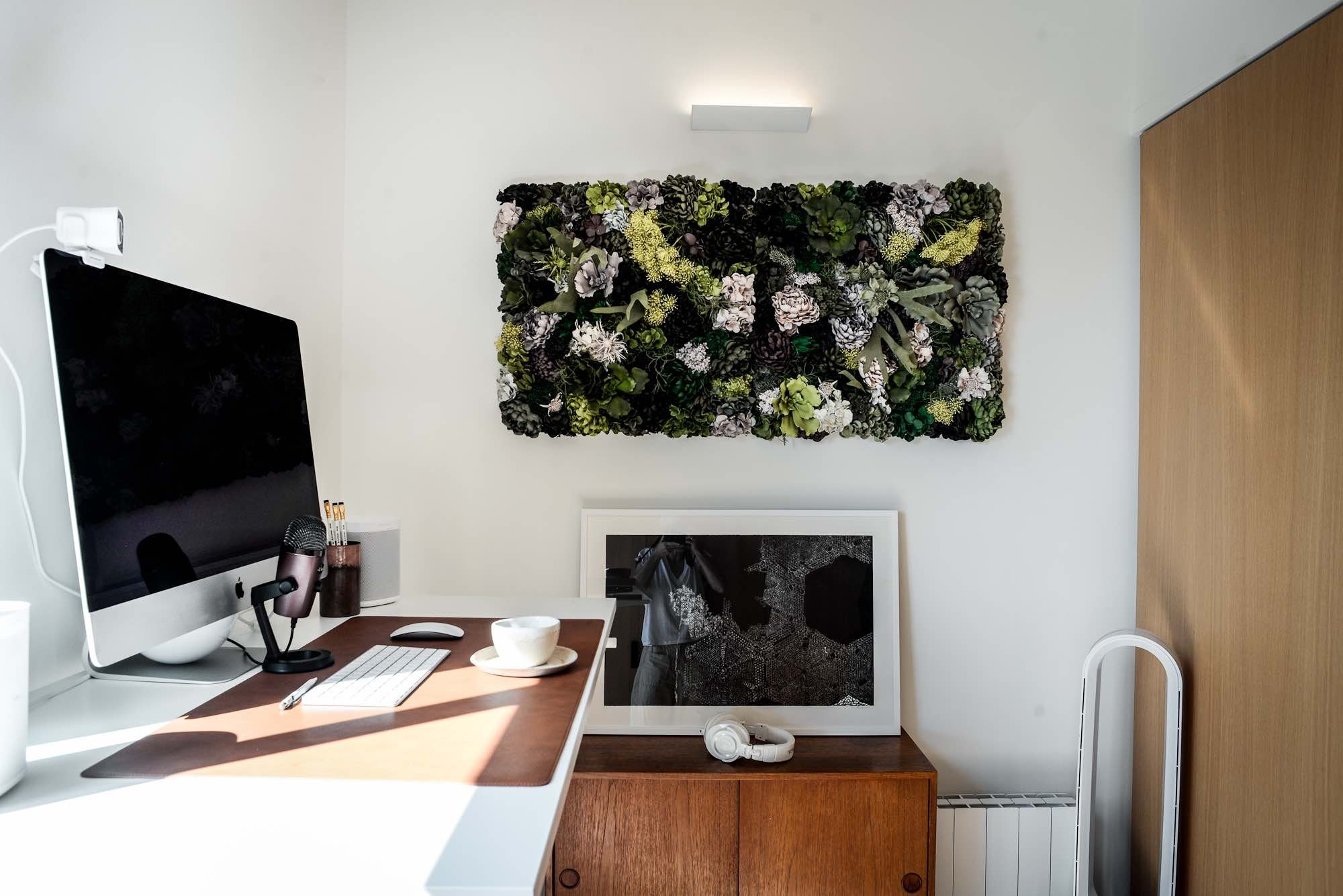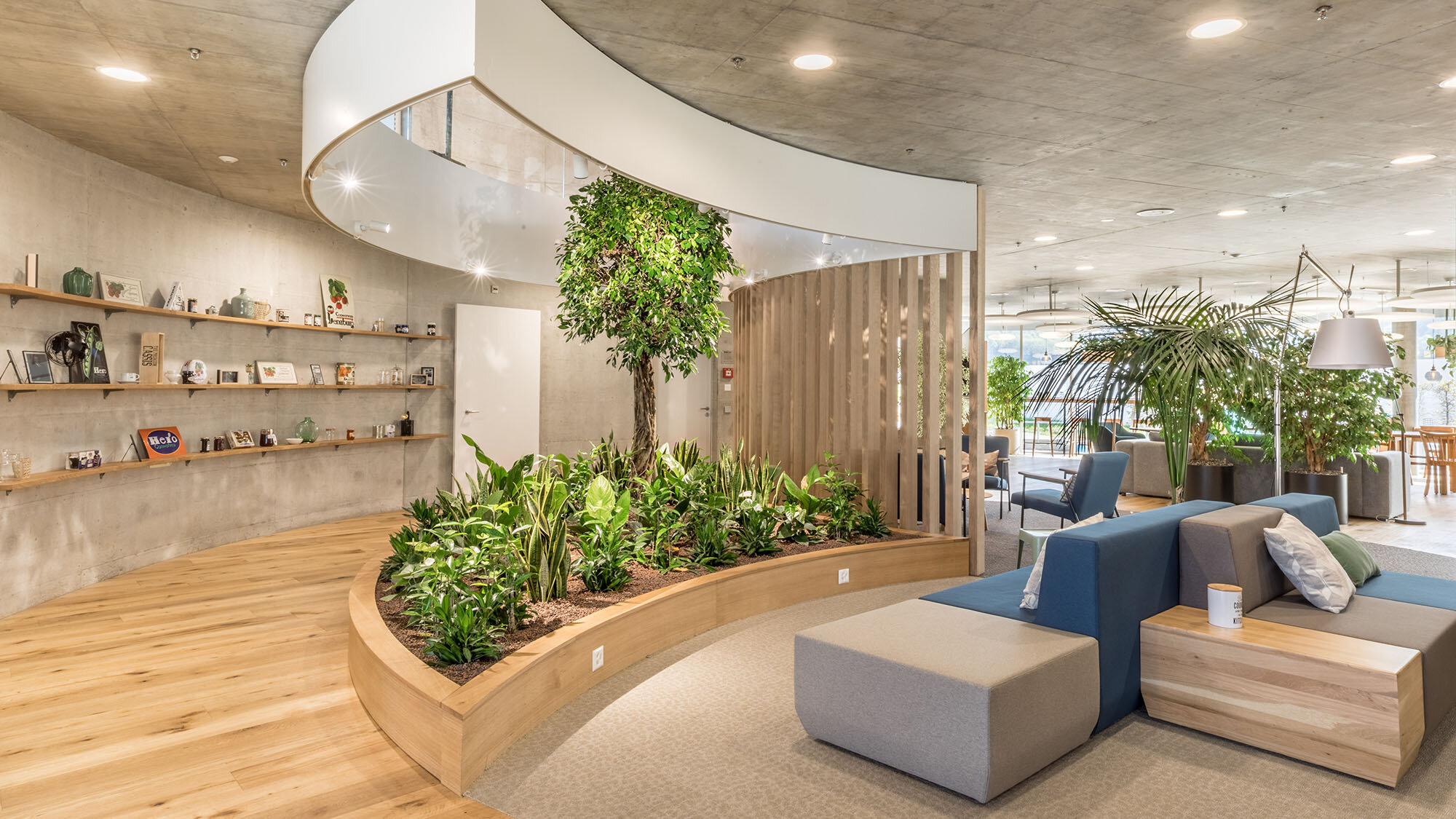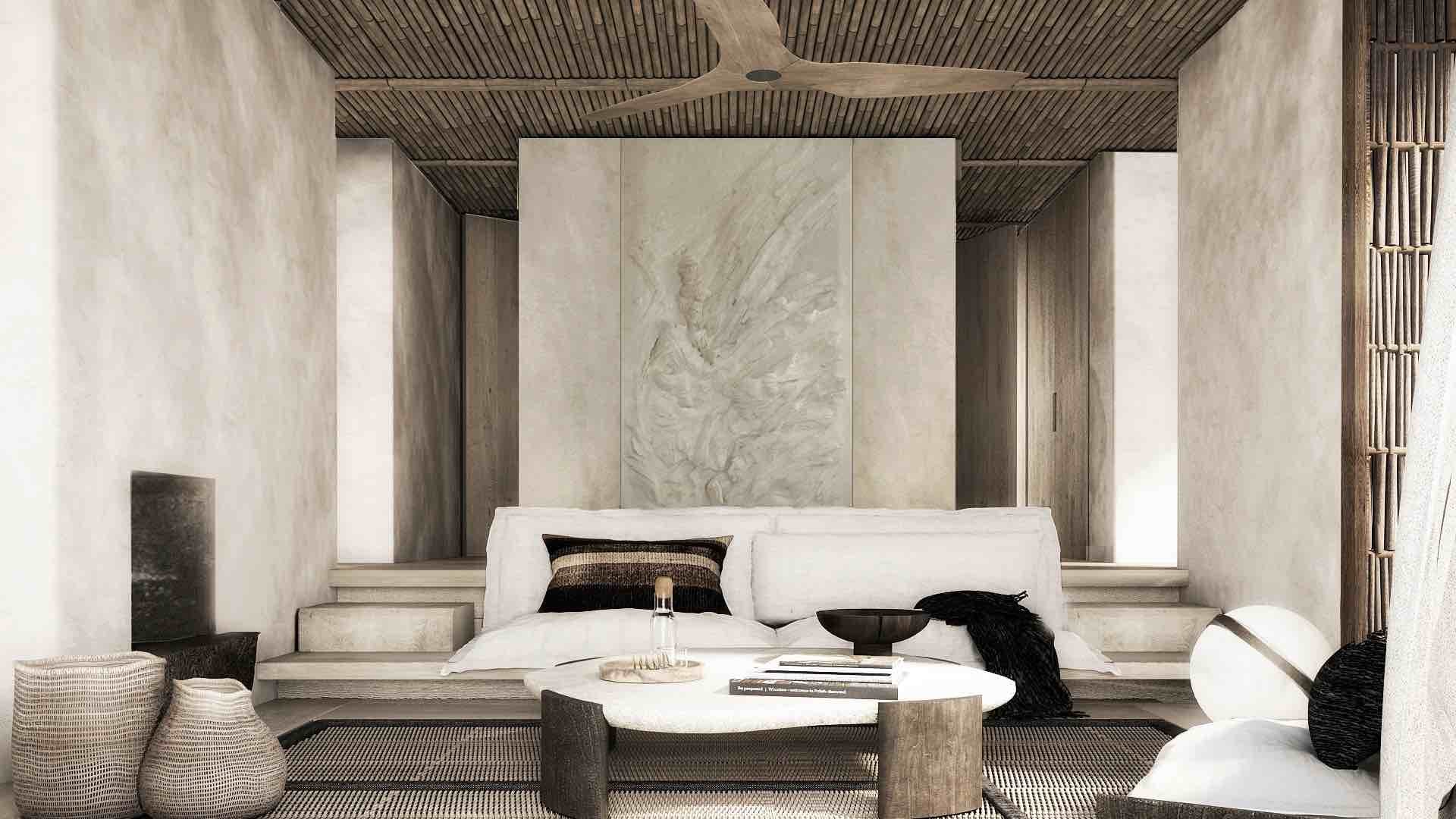Biophilic design CONSULTANT & INTERIOR DESIGNERS
We provide biophilic interior design consultation services for real estate developers, hotel brands and architecture studios, integrating sustainability and wellbeing
what is biophilic design meaning?
As biophilic design consultants we aim to bring the outside world in whilst considering our environmental impact and positively influencing occupant wellbeing. This holy trinity of nature + sustainability + wellness is the definition of biophilic design as applied within a wellbeing interior and healthy building strategy, benefitting physical and mental health as well as the environment.
what is biophilic design concept?
The elements of biophilic design at our disposal as an interior designer cover both direct and indirect biophilia, from air-purifying plants to living walls, flooring, wall decor, acoustic panels, artworks, sound, scent, fabrics and upholstery. Essentially we are looking to using a biophilic design concept to improve the indoor air quality, boost occupant mood and productivity whilst reducing stress levels.
what are benefits of biophilic design?
In terms of wellbeing, interior spaces featuring a biophilic design concept have been proven in scientific research studies to reduce anxiety, enhance mood, restore concentration and creativity levels and provide a sense of vitality / nature-connectedness. True biophilic design also incorporates sustainable design principles in order to minimize environmental impact to an absolute minimum. This should be an integral part of the interior design process.
Biophilic Interior Design Services
Indoor plants in biophilic design interiors
Residential interior and plant selection by Biofilico
Air-purifying plants and botanical design are fundamental to biophilic design principles, making them one of the most important biophilic design elements, whether vertical gardens, in planter boxes, vertical gardens, indoor gardens, green roof gardens, hydroponic vertical farm towers, or suspended from the ceiling.
As biophilic designers we leverage botanicals for all their wellness benefits.
Natural beauty in biophilic design interiors
Moss wall by Biofilico for HERO Group, Switzerland
Any definition of biophilic design will likely suggests it can transform a space into a harmonious collection of natural elements that boost mood, productivity and wellbeing. Integrating a sense of place through local artworks and materials is one example, as are using natural patterns and textures.
The glue that holds it all together in our opinion as biophilia experts advising developers, landlords and tenants however, is the less tangible concept of natural beauty. Interiors that nourish the soul are good for overall occupant happiness levels.
Natural materials in biophilic design interiors
Co-working interiors by Biofilico with bespoke desk
The value system behind biophilic interior design entails using sustainably sourced organic materials such as wood, cork, wool, leather and stone.
A biophilic design concept can also integrate circular economy materials made from coffee grinds, railroad timber, seaweed and coconut fibre, amongst many others.
We also specialise in plant-based materials, fruit byproduct materials, upcycled ocean plastic fabrics amongst others. This approach ensures an elemental, cohesive aesthetic every time.
Restorative spaces in biophilic design interiors
Ecology Room restorative space concept by Biofilico
We design biophilic outdoor spaces, multi-sensory recharge rooms or ‘restorative spaces’ with a strong connection to nature as a way to stimulate physical or mental activity, exposure to daylight and enhance overall wellbeing in building occupants. These are especially relevant for healthy coworking offices and workspaces for example.
A key component of the WELL Building Standard, FITWEL healthy building, Living Building Challenge and LEED green building systems, recharge rooms and outdoor spaces with landscaping or other natural features have been proven to reduce stress and promote feelings of vitality through biophilia.
Multi-sensory design in biophilic design interiors
Our Vitamin Nature space for EcoWorld Ballymore and The Wardian, London, UK
In its quest for harmony with nature, biophilic interior design can integrate sound-absorbing solutions for acoustic comfort such as acoustic panels, moss walls, privacy booths and eco flooring panels that reduce ambient noise while adding a natural aesthetic into a space.
Sound wellness is an emerging trend that includes biophilic sound interventions. To create a truly multi-sensory experience, aromatherapy can be used in HVAC ducts to energise or regenerate.
See our case study on the Vitamin Nature space research study for The Wardian Case / EcoWorld Ballymore in London, UK.
Access to biophilia indoors
Indoor garden for HERO global headquarters, Switzerland (photo Daniel Werder)
A key component of the WELL, Living Future and LEED green building standards, providing access to indoor spaces via indoor landscaping has a positive impact on mental health making this biophilic design concept ideal for workplaces and residential buildings as well as spas and gyms.
Our biophilic house design strategies look to enhance access to natural light, views onto nature and fresh clean air, all of which help avoid ‘Sick Building Syndrome’. As a commercial interior design consultancy this expertise can be delivered as a complete design service, or as an external advisor assisting the lead project architects and interior designers.
Indirect Biophilia in Interior Design
Healthy home office by Biofilico - showing a botanical artwork on the wall
From faux flower installations to nature-inspired wall murals, botanical artworks, moss mosaics, terrariums and more, there is a myriad of such ‘indirect’ representations of nature available to us as biophilic designers.
These solutions are ideally suited to spaces with low or no natural light, meaning living plants would struggle to survive. Even such representations of nature provide many of the same stress-reducing mental health properties as living plants without the operational responsibility.
Organic Design & Wabi-sabi interiors
Residential interior display by Biofilico
Wabi-sabi is a Japanese concept meaning beauty in natural imperfection, a key tenet of organic interior design.
We implement this concept in our biophilic interior consulting work via the introduction of natural, organic and handmade artworks, rugs, sculptures, fabrics and materials that add patina and texture to a biophilic interior space.
This is in contrast to industrialized, machine-made materials that lack the natural patina of age - a key concept in biophilic design principles.
So while this design aesthetic may be less applicable to an office design consultancy assignment, it is especially relevant for hotels, resorts, restaurants and residential contexts.
Biodesign & biomimicry in biophilic design
Mushlume lampshade by Danielle Trofe
An increasingly prominent component of the biophilic design concept, ‘biodesign’ typically relates to biophilic products in particular rather than biophilic interiors in general.
A biodesign will likely feature bio-materials that protect valuable natural resources and cause no harm to the planet, or perhaps biofabrication that involves growing a product from a natural material such as mycelium.
Biomimicry really takes nature as a guide to create a rigorous methodology of imitation and cross-fertilization between nature and industrial design or architecture.
Biophilic design in green and healthy building standards
One of the main benefits of biophilic design is that it straddles the world of sustainable green buildings and healthy buildings, even playing a role in wellbeing interior design.
Projects pursuing LEED, BREEAM, WELL (see our article on this subject here) or Living Building Challenge for example, will all receive recognition for integrating elements of biophilic design, such as landscaping, gardens, views of nature and plant walls.
Interestingly, one biophilic design concept can easily score on both certifications, meaning it delivers plenty of bang for the buck! So the “what is biophillic design?” can often be answered from two different angles!
Biophilic design, sustainability and wellbeing
We define biophilia as ‘the human love of or need for a close connection with nature and other forms of life' - an attempt to reunite indoor and outdoor worlds through the sensitive use of natural materials, shapes, breezes, colors, scents, and sounds in urban architecture and interiors.
As biophilic design consultants working in the healthy buildings sector, we view biophilic design as being a fundamentally Triple Bottom Line concept as it brings benefits for People, Planet and bottom line Profit.
Biophilic sound & wellness sounds
As part of a wellness interior inspired by nature and maximized for wellbeing benefits, various options are available to integrate mood-boosting, stress reducing sounds.
These would ideally be recorded nature sounds from nearby locations with seasonal variations but high-quality, pre-recorded wellness sound playlists are also available from a number of brands such as Delos and Swell.
For more info on our expert biophilic sounds partner Swell see here.
Lighting in biophilic design interiors
Spaces maximized for biophilic design benefits aim to make the most use of the natural daylight available, allowing it to filter through into the core of the building’s floor plate.
Smart lighting systems with LED bulbs can provide different light tones and intensities during the day to follow the body’s natural 24hr cycle.
A combination of natural daylight, task lights (e.g. desk lamps or bedside lamps), uplights (e.g. standing lamps) and ceiling lights on a smart system will all help create an interior designed for wellbeing.
Why Choose Our Biophilic Design Consultants?
Our role as biophilic designers goes from the masterplan phase into concept design, detailed design and fit-out phases, with post-occupancy deliverables such as occupant satisfaction surveys.
Understanding the role of biophilic design in building certifications such as BREEAM, WELL and FITWEL ensures smooth integration into a wider project team alongside architects, engineers, lighting designers, acoustics consultants and client representatives.
Journal articles related to biophilic design
+ What are the principles of biophilic design and their effects?
Biophilic design concept uses human connection to nature and applies it to the world we live in, our built environment. Whether on a smaller or a larger scale, this concept has proven benefits for human health, as well as added environmental and economic benefits.
The fundamental connection we have to nature has forced us to seek ways to bring nature back into our lives, and even more so, make it a crucial part of the environment we spend our time in the most, which is why we incorporate biophilic design into architecture and interiors.
Biophilic design has shown remarkable restorative and enhancing effects on human lives, whether concerning their everyday living or working environment.
+ Biophilic principles and their effects - beauty and function
Biophilic design principles are based on elements that offer benefits far greater than the initial aesthetic impression.
Biophilic design has been proven to have a range of benefits so let’s take a look at some of them:
Increases productivity and creativity in workplaces Improves patient recovery in hospitals Reduces crime rates in residential areas Increases learning abilties and test results in schools Reduces anxiety and stress levels
+ Biophilic design principles and benefits they invoke
The multi-sensory experience of nature, especially the visual, olfactory, acoustic and tactile, provide a connection that is fundamental to biophilic design principles, which is why they are based on: light, air, water, plants, textures and materials.
Biophilic design is about more than just plants it is a concept that enriches our everyday lives in a range of meaningful ways.
+ Happiness emerges from healthy environments
Biophilic design principles rest on simple but effective solutions - interventions that mimic natural systems, and that ultimately lead to decreased stress levels and enhanced creativity. This is particularly noticeable in workplaces where monotonous, bland interiors do very littl to kep the workforce happy.
Biophilic design can inspire through its beauty but also calm, and soothe, enhancing wellbeing in the workplace and boosting productivity.
+ Plants are key biophilia but not the only things that matter
Yes biophilic design may appear to begin and end with plants but that is really just the beginning. We consider biophilic design both in direct and indirect terms.
Biomorphic patterns and arrangements seen in nature can be an indirect form of biophilia that evokes similar responses in us as a direct form of nature would have. This seems counter-intuitive but representations of nature are highly effective too!
The patterns and fractals used in biophilic design are referred to as biomimicry for example, showing that biophilic design principlescan extend out into a number of creative design solutions.
+ Natural light is one of the basic biophilic design principles
Maximizing natural lighting is also one of the main biophilic design principles.
The lighting that changes either naturally or artificially over the course of the day, therefore mimicking our circadian rhythm helps, which in turn helps us be more in sync with natural environment, and on track with the 24-hour cycle.
Aside from helping us be more in balance with the natural ebb and flow of sunlight, maximizing exposure to natural light during the day enhances visual comfort, which is of importance to workplace wellness.
+ Water, air, sound and smell - the basics that shape the whole
Apart from light, other key elements that we subconsciously associate with nature are water and air.
It was proven that interventions of biophilic design that add the presence of water in the mixture lead to several health benefits, such as lower blood pressure, lowered heart rate as well as better memory recall, but most of all, it’s a feeling of tranquility and serenity that water invokes in us, that makes it such an important component of biophilic design.
Airflow, on the other hand, keeps us awake, gently stimulating our senses, when done correctly.
Most of the time you will find that, when it comes to closed spaces, the advice is to keep the temperature in the room constant, since our bodies tend to overreact at such sudden changes.
However, constant temperature leads to a stuffy atmosphere that eventually leads to sleepiness, something as common as airflow stimulation can easily improve that. It keeps people awake, more focused and generally better performing.
The last consideration is scent and sound, two more biophilic design principles that help create a mulit-sensory experience.
+ Nature mimicking elements
The challenge biophilic design often comes across is the existing limitations of the space you want to improve. It can be complex, or near impossible to add a window to an existing building for example, so we have to find creative alternatives.
This is where indirect forms of nature can enter the equation. Mimicking nature in the form of adding some nature-depicting paintings or biomorphic patterns improves the perception of space, making these elements a more than viable option.
+ Biophilic principles in vernacular architecture
Biophilic principles are also evident in so called “vernacular architecture”, where buildings are constructed in a way that reflects the landscape around them.
This particular type of architecture combined with biophilic interior design allows people to form bonds with the natural world around them in a more profound way.






















